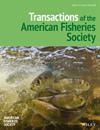宾夕法尼亚州苏斯奎汉纳河流域外来扁头鲶鱼的摄食习性和生态影响
IF 1.4
3区 农林科学
Q2 FISHERIES
引用次数: 0
摘要
目标平头鲶(Pylodictis olivaris)是美国一种广泛的水生入侵物种,最近入侵了宾夕法尼亚州的苏斯奎汉纳河流域。扁头鲶是一种食鱼动物,以捕食本地鱼类和重要的休闲鱼类而闻名。在美国大西洋中部,这种入侵者如何影响食物网以及哪些物种可能面临最大的捕食风险尚不清楚。为了填补这一知识空白,我们对从平头鲶鱼身上采集到的胃内容物进行了DNA条形码编码,以确定猎物物种并阐明平头鲶鱼在苏斯奎汉纳河中的潜在捕食影响。方法我们使用贝叶斯分层多变量概率模型来研究猎物物种在平头鲶鱼食物中出现的概率是否随季节变化或与平头鲶鱼的体长有关。我们总共鉴定出 47 种不同的猎物。最常见的猎物物种是锈色小龙虾(Faxonius rusticus)、薮鳢(Noturus insignis)和胫鱼(Notropis spp)。虽然不同长度等级的平头鲶(<300 mm, 301-600 mm, 601-900 mm TL)出现猎物物种的频率不同,但锈色小龙虾是常见的猎物(33.结论我们发现,鲶鱼的体长和季节性确实会对几种猎物的出现概率产生不同的影响。例如,峡鲶(Ictalurus punctatus)更有可能出现在较短的平头鲶中,而小口鲈(Micropterus dolomieu)则出现在较大的平头鲶中。我们展示了平头鲶捕食的显著变化,增加了我们对捕食者-猎物动态的了解,这对于更好地管理和确定未来对苏斯奎汉纳河流域水生生物群落的影响是必要的。本文章由计算机程序翻译,如有差异,请以英文原文为准。
Feeding habits and ecological implications of the invasive Flathead Catfish in the Susquehanna River basin, Pennsylvania
ObjectiveFlathead Catfish Pylodictis olivaris are a widespread aquatic invasive species within the United States and a recent invader in the Susquehanna River basin, Pennsylvania. Flathead Catfish are piscivores known to consume native and recreationally important fish species. In the mid‐Atlantic United States, it is unknown how this invader is impacting food webs and which species may be at greatest predation risk. To address this knowledge gap, we DNA barcoded stomach contents collected from Flathead Catfish to identify prey species and elucidate potential predatory impacts of Flathead Catfish in the Susquehanna River.MethodsWe used a Bayesian hierarchical multivariate probit model to investigate if the probability of prey species occurrence in the diets of Flathead Catfish varied seasonally or was a function of Flathead Catfish length.ResultA total of 576 Flathead Catfish were collected during 2020–2021, with 241 individuals having recoverable stomach contents. In all, we identified 47 different prey species. The most common prey species were rusty crayfish Faxonius rusticus , Margined Madtom Noturus insignis , and shiners Notropis spp. While frequency of occurrence of prey species differed across Flathead Catfish length classes (<300 mm, 301–600 mm, 601–900 mm TL), rusty crayfish were commonly found (33.7–44.0% of diets) in stomachs of all size‐classes.ConclusionWe found that Flathead Catfish length and seasonality did influence occurrence probability differentially for several prey species. For example, Channel Catfish Ictalurus punctatus were more likely to appear in shorter Flathead Catfish while Smallmouth Bass Micropterus dolomieu appeared in larger Flathead Catfish. We demonstrate significant variation in Flathead Catfish predation, increasing our understanding of predator–prey dynamics, which is necessary to better manage and identify future impacts to aquatic communities in the Susquehanna River basin.
求助全文
通过发布文献求助,成功后即可免费获取论文全文。
去求助
来源期刊
CiteScore
2.90
自引率
7.10%
发文量
48
审稿时长
8-16 weeks
期刊介绍:
Transactions of the American Fisheries Society is a highly regarded international journal of fisheries science that has been published continuously since 1872. It features results of basic and applied research in genetics, physiology, biology, ecology, population dynamics, economics, health, culture, and other topics germane to marine and freshwater finfish and shellfish and their respective fisheries and environments.

 求助内容:
求助内容: 应助结果提醒方式:
应助结果提醒方式:


